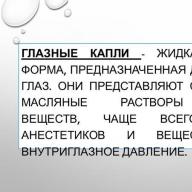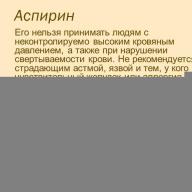





Tablet Solid dosage form obtained by the factory - a method of pressing medicinal and auxiliary (sugar, starch, sodium bicarbonate, etc.) substances intended for internal use. All tablets are official.
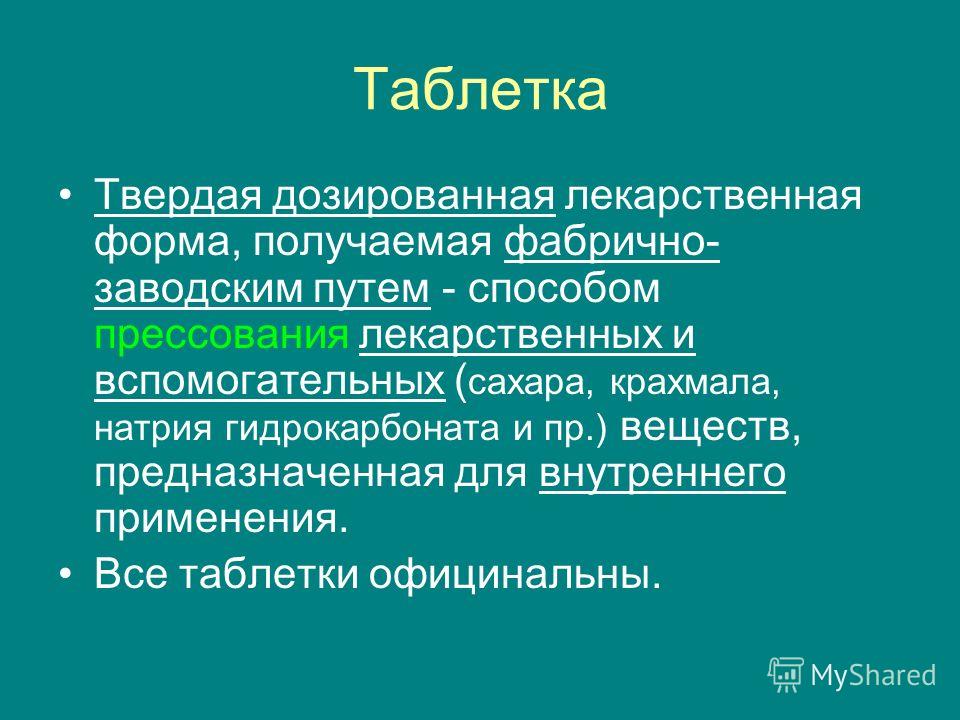
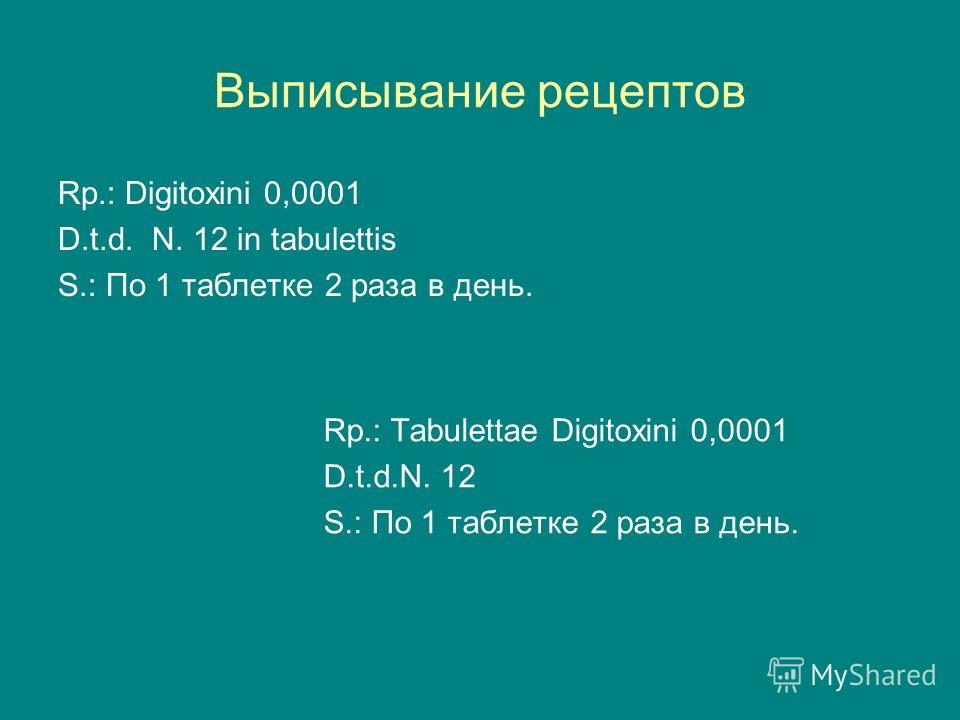


Granules Solid dosage form in the form of homogeneous particles of round, cylindrical or irregular shape, obtained by the factory, intended for internal use. All granules are official. As excipients use sugar, sodium bicarbonate, starch, food coloring.


Films (plates) solid dosed official dosage formsare polymeric oval or rectangular with rounded edges films and plates containing a medicinal substance. The inclusion of a drug substance in a film of bio-soluble polymer provides a quick onset of effect and a prolonged effect. Applied by application to the mucous membrane of the oral cavity (for example, in the upper gum above the small molars).
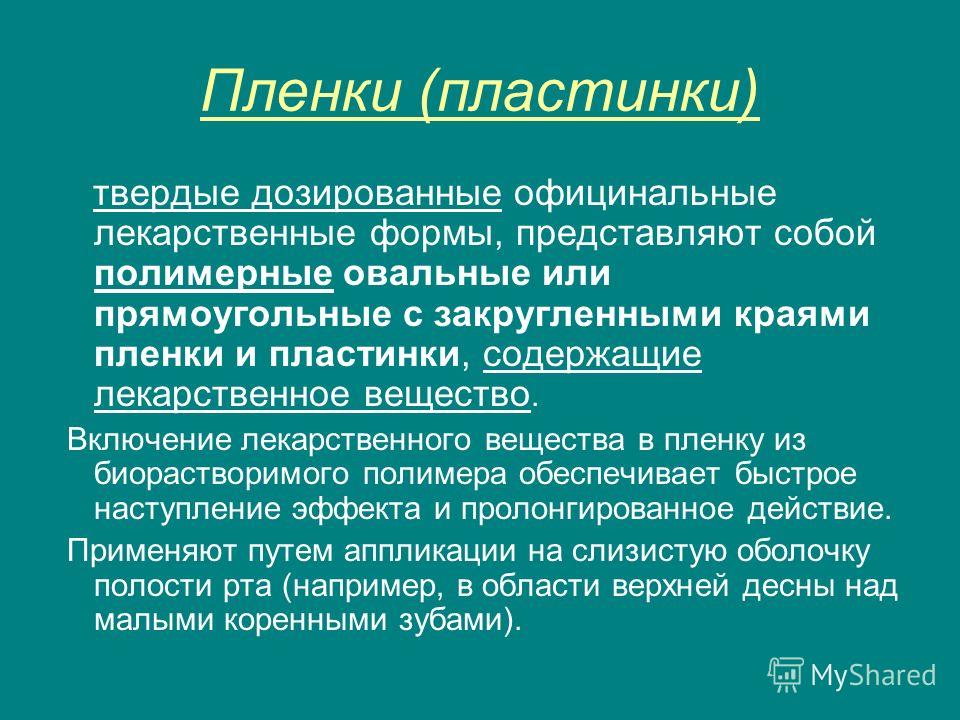
Solid lozenges and caramel formulated solid dosage forms prepared by mixing medicinal substances with sugar and mucus, usually flat. They are prescribed for the treatment of diseases of the oral mucosa or pharynx. The lozenges are kept in the mouth until completely resorbed.


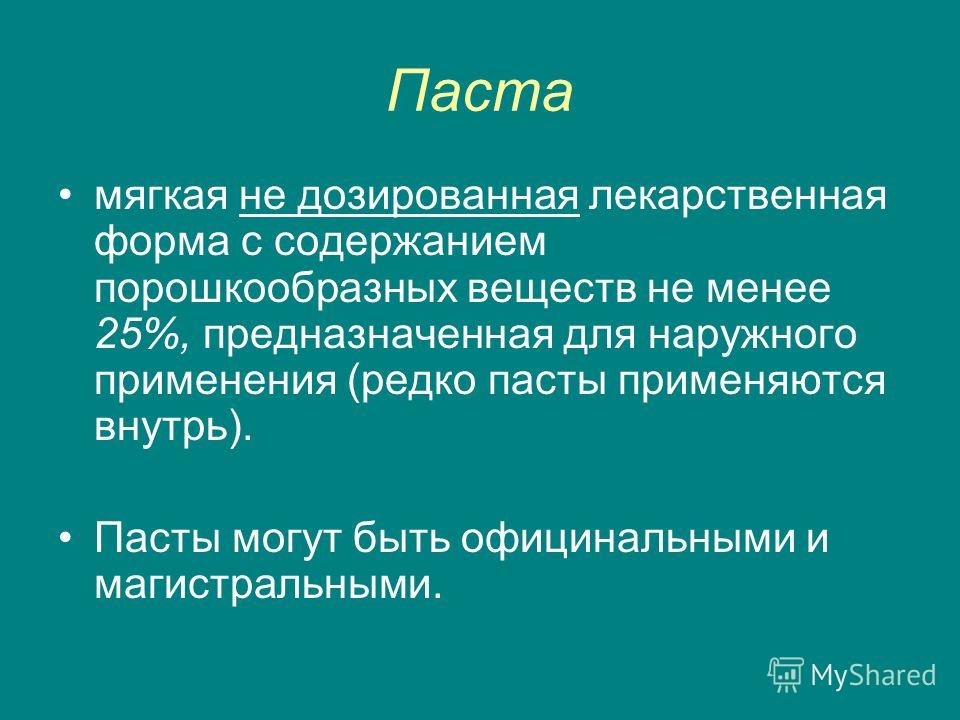



Ointment bases 1) petrolatum (Vaselinum); 2) lanolin (Lanolinum); 3) solid paraffin (Paraffinum solidum); 4) vaseline oil (Oleum Vaselini); 5) naphthalan ointment (Unguentum Naphthalani); 6) pork fat (Adeps suillus depuratus); 7) beeswax yellow and white (Cera flava, Cera alba); 8) spermaceti (Cetaceum);
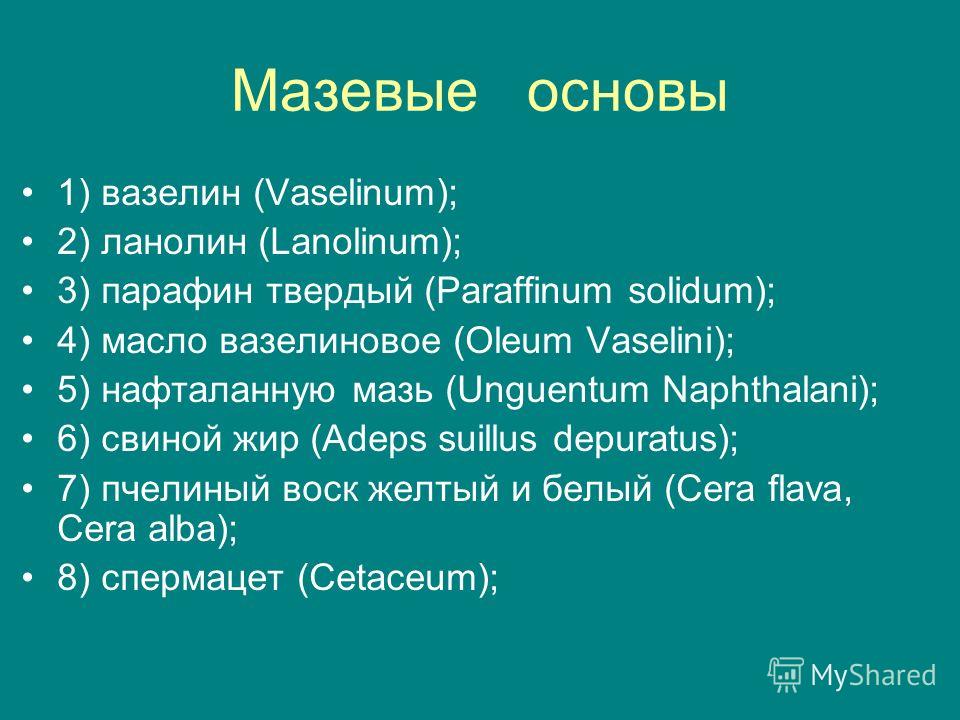
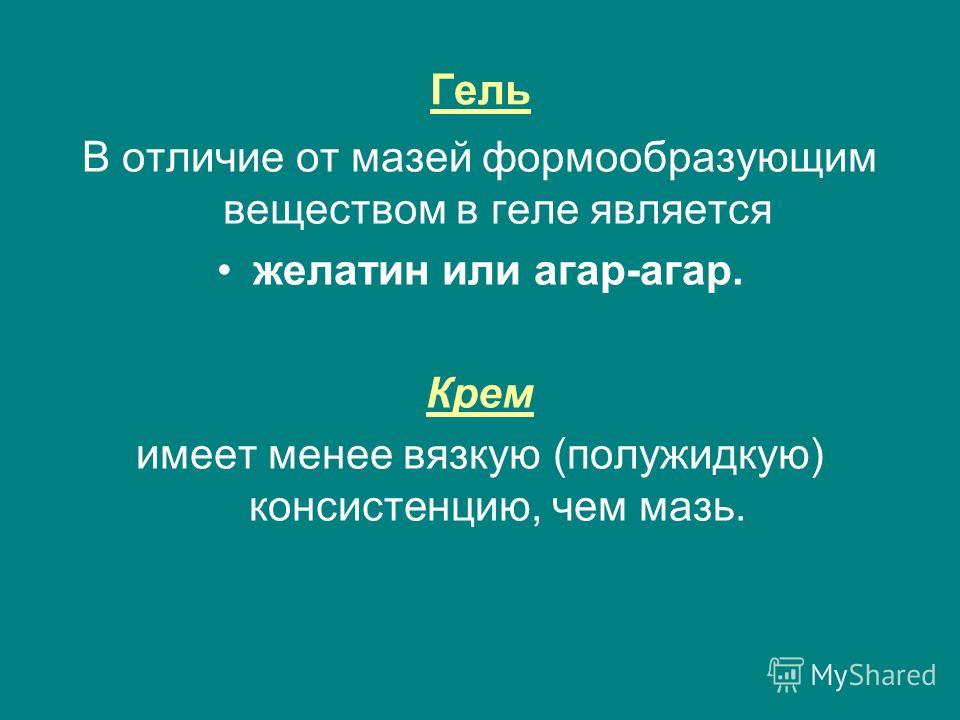
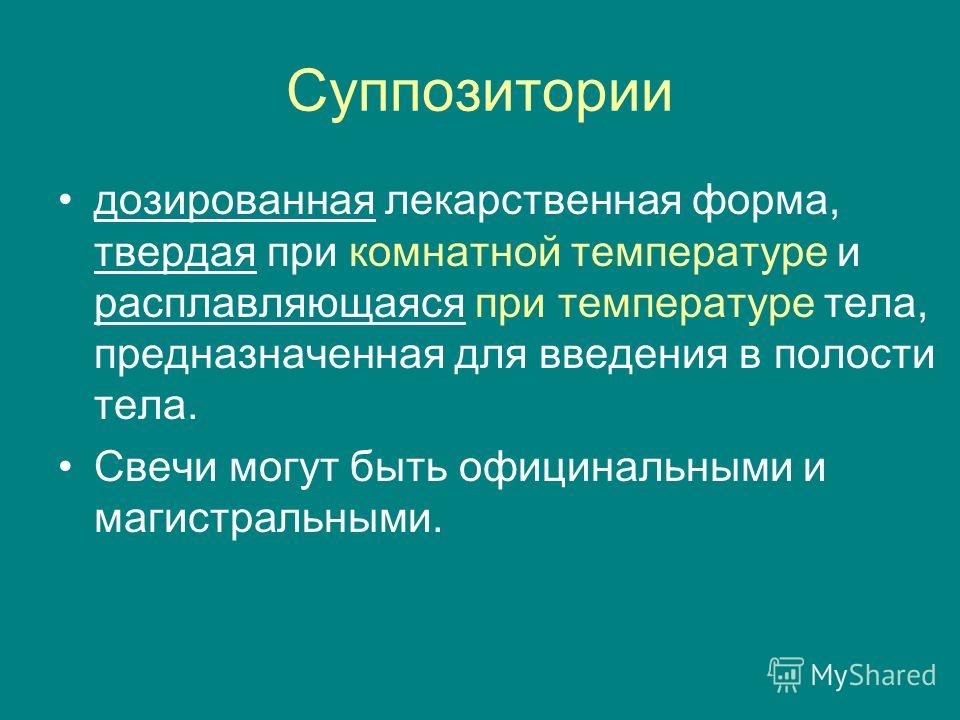

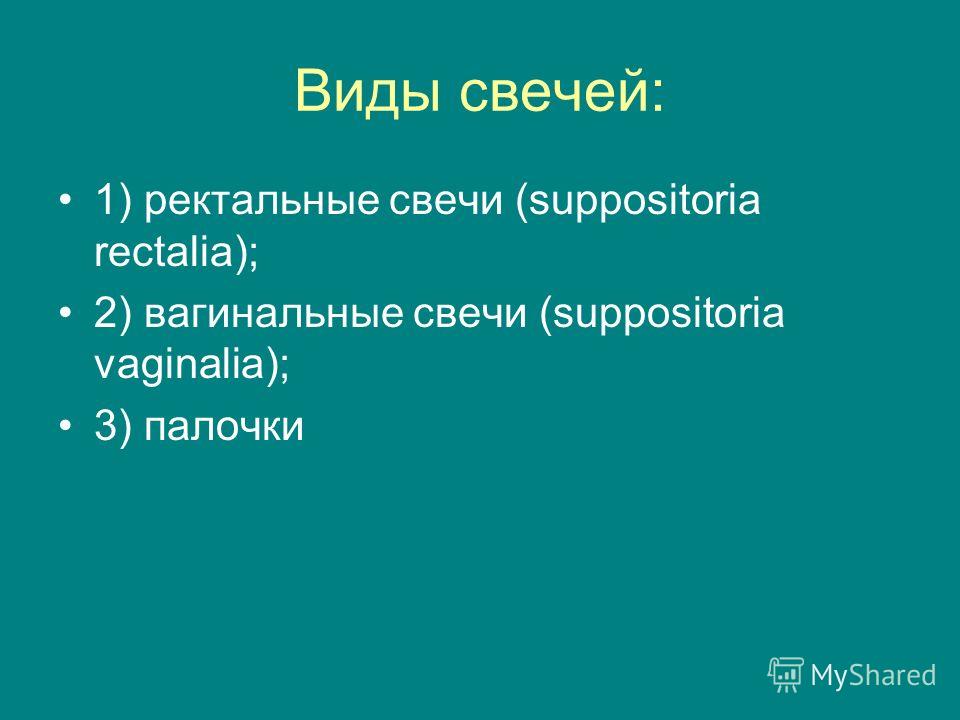
The patch is a soft official dosage form for external use in the form of a plastic mass with the ability to soften at body temperature and adhere to the skin, or in the form of the same mass on a flat carrier. -dosed - not dosed.
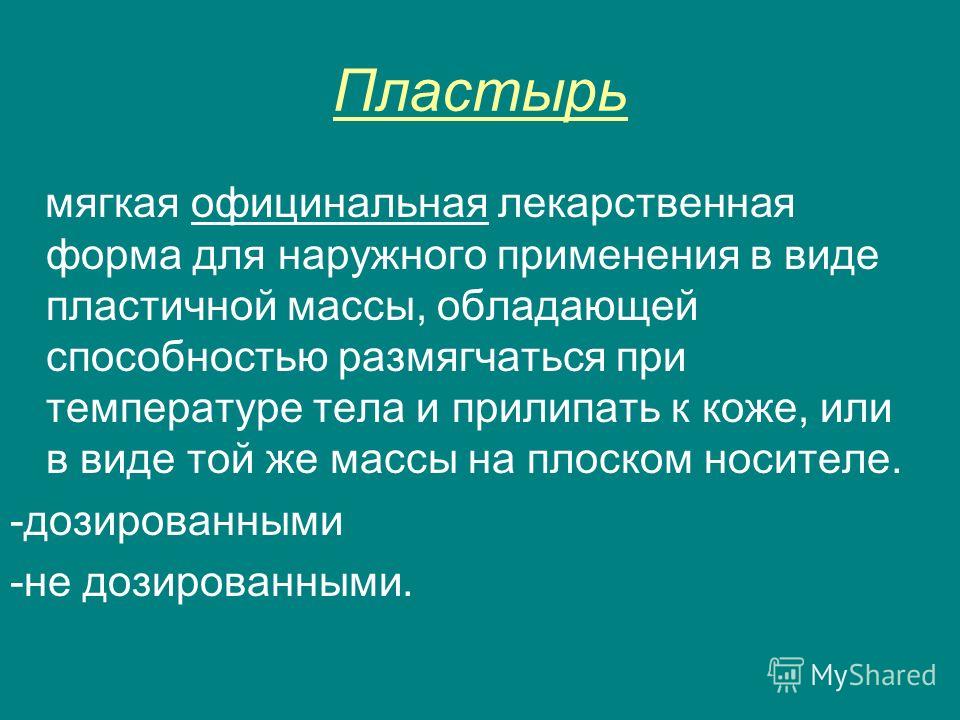
List of sources used Literature 1. D. Kharkevich - Pharmacology. Publisher: M.: GEOTAR-Media. Year of release: Maysky V.V. - Pharmacology for students. 288 questions and answers. Publisher: M.: GEOTAR-Media. Release year: 2007
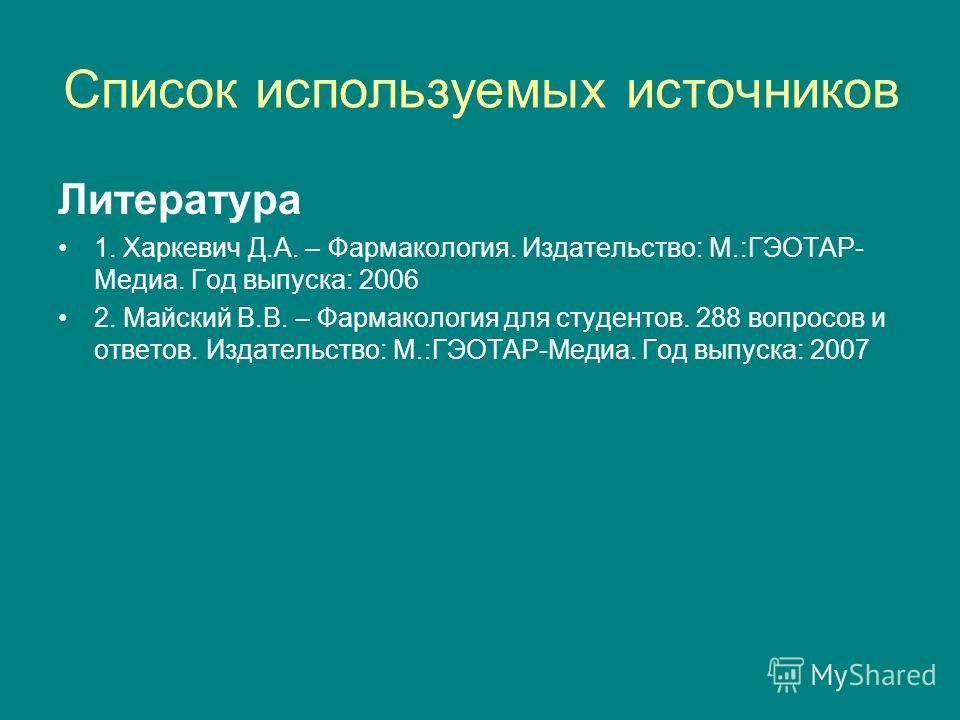
Section 1
GENERAL RECIPE (PHARMACOLOGY)
The general prescription is the pharmacology section on the rules for prescribing drugs. Prescribing and dispensing drugs on them are carried out in accordance with the rules of prescribing
recipes, which are determined by orders of the Ministry of Health. All prescriptions are divided into official and trunk.
Solid dosage forms
Solid dosage forms include powders, capsules, tablets, dragees, granules, etc.
Powders (Pulveres) intended for external or internal use. They can be simple and complex, metered and undosed. Underdosed powders are usually applied externally as powders. In the recipe, the name of the substance, its amount and degree of grinding are indicated.
Rp. Streptocidi subtilissimi 10.0
D S . Apply on affected skin
Dosage powders are used orally. Distinguish between simple and complex metered powders. The prescription indicates a medicinal substance with a single dose designation. Then the pharmacist is instructed on the number of powders:D t. d. No ...
Rp. Sulfadime z ini 1.0
D t. d. Number 20
S . 1 powder every 4 hours
In the case of prescribing complex powders in the recipe indicateM. f. p ulvis.
Rp. Dimedroli 0.015
Sacchari 0.2
M. f. p ulvis
D t. d. Number 20
S . 1 powder 3 times a day
The list of powders of plant origin begins with the wordPulveris , then indicate the part of the plant, its name (for example,PulverisradicisRhei) and dose.
Often powders are enclosed in capsules:
Rp. Rifampicini 0.15
D.t. d. No. 20 in capsulis
S . 1 capsule 2 times a day
Pills (tabulettae)- these are solid dosage forms obtained by compressing drugs or mixtures of drugs and excipients. They are used orally, sublingually, intravaginally, for the preparation of solutions, etc. Tablets are prescribed in two ways:
1) The most common is the prescription, which indicates the name of the medicinal substance and its single dose, followed by a prescription on the number of prescribed tablets -D t. d. No ... in tabulettis.
Rp. Nitroglycerini 0.0005
D.t. d. No. 20 in tabulettis
2) The second option for prescribing tablets begins with an indication of the dosage form, i.e. from the wordTabulettam (vin.p. unit), then indicate the name of the medicinal substance and its single dose.
Rp. Tabulettam (Ta b.) Nitroglycerini 0.0005 No. 20
D S . 1 tablet under the tongue for pain in the heart
There are tablets of complex composition with a special patented name: "Citramon", "Besalol", etc. When writing them indicate the name of the dosage form - (Tabulettas - win.p. many h.), the name of the tablets and their number.
Rp.: Tabulettas (Ta b.) Citramonum No. 20
D S . On a pill for headache
Among the tablets stand out: not coated and coated with various membranes (slowing down disintegration and absorption, protecting the mucous membrane from the irritating effect of drugs); "Enteric-soluble" - ensuring the passage of a substance through the stomach in an unchanged form and disintegrating in the intestine; Effervescent - solubleextempore in water with the formation of an "effervescent" (carbonated) drink; "Chewing" and others.
Jelly beans obtained by repeated layering of medicinal and auxiliary substances on granules. There is only one form of prescription dragee. The prescription begins with an indication of the dosage form (Dragee - win.p. unit), followed by the name of the medicinal substance, its single dose, the number of dragees and the signature.
Rp: Dragee Diazolini 0.05 No. 20
D S . 1 tablet 2 times a day
Liquid dosage forms
Liquid dosage forms include solutions, infusions, decoctions, tinctures, extracts, suspensions,
mucus, potions.
Solution (Solutio) It is used for external (eye, ear drops, lotions, flushing, etc.) and internal use, as well as for injection. Allocate water, alcohol, oil solutions. They are written out in an expanded and abbreviated way.
Rp.: Furacilini 0.1
Aquae purificatae 500 ml
M. D S . Gargle
When prescribing aqueous solutions indicate in the genitive case the name of the dosage form -Solutionis , the name of the medicinal substance, the concentration of the solution and (through the dash) its amount in milliliters or grams.
The concentration of the solution is indicated in one of three ways: most often - in percent, less often (at large dilutions) - in ratios(e.g. 1: 1000, 1: 500, etc.) and in mass-volume ratios (e.g. 0.1 - 200ml, 0.5 - 180 ml, etc.).
Rp. Sol utionis (Sol.) Furacilini 0.02% - 500 ml
D S . Gargle
Rp. Sol utionis (Sol.) Furacilini 1: 5000 - 500 ml
D S . Gargle
Rp. Sol utionis (Sol.) Furacilini 0.1 - 500 ml
D S . Gargle
In abbreviated versions of the prescription of solutions sentenced in alcohol or oil, it is necessary to indicate the type of solvent.
Rp. Solutionis (Sol.) Iodi spirituosae 5% - 10 ml
D S . For treating wound edges
Infusions and decoctions (Infusum et Decoctum)- aqueous extracts from medicinal plant materials or aqueous solutions of extracts-concentrates specially designed for this purpose. They are intended for internal and external use (rinses, lotions, etc.). When used internally, they are dosed with spoons, parts of a glass. They are written out indicating the type of raw material, the name of the plant, the amount of raw material for preparing the required
Amounts of infusion or decoction.
Rp. Infusi herbae Leonuri ex 10.0 - 200 ml
D S . 2 tablespoons 3 times a day
Tincture (Tinctura)is a water-alcohol extract from medicinal plant materials. All tinctures are official. When prescribing, unlike infusions, neither the part of the plant from which the tincture is prepared nor the concentration of tinctures is indicated. The prescription begins with the name of the dosage form -Tincturae , then the name of the plant follows and the amount of tincture is indicated. Dose tinctures with drops.
Rp. TincturaeAbsinthii 25 ml
D S . 15 drops 30 minutes before meals
Extracts (Extract a)are concentrated extracts obtained from medicinal plant materials. Depending on the consistency, the extracts are liquid, thick and dry. Liquid extracts are colored liquids, thick extracts are viscous masses with a moisture content of not more than 25%, dry ones are granular masses with a moisture content of not more than 5%.
All extracts are official. When prescribing extracts, neither the type of medicinal raw material nor the concentration in the recipe indicate, but an indication of the nature of the extract is mandatory.
Liquid extracts are prescribed similarly to tinctures. Thick and dry extracts are prescribed in capsules, powders, tablets, suppositories.
Rp. Extracti Crataegi fluidi 25 ml
D S . 15 drops 3 times a day
Novogalenovye dosage forms receive as a result of special processing of vegetable medicinal raw materials. They differ from galenical (tinctures, extracts, infusions, decoctions) in a high degree of purification from ballast substances and contain mainly the sum of the active substances of plant materials. They are prescribed not only inside, but also parenterally.
Each newgalenic drug has a special name. When writing them out in the recipe, only their name and quantity are indicated, since they are official.
Rp. Adonisidi 15 ml
D S . 15 drops 3 times a day
Potions (Mixturae) are a non-dosage form. They contain 3 or more ingredients. They are obtained by dissolving or mixing in various liquid bases several solids or when mixing several liquids. Assign most often inside.
They are discharged in an expanded manner indicating all the ingredients.
Rp. Infusi herbaeAdonidisvernalis 6.0 - 180 ml
Natrii bromidi 6.0
Codeini phosphatis 0.2
M.D.S. 1 tablespoon 3 times a day
Injection Dosage Forms available in ampoules, vials, which must be sterile. In ampoules and vials, solutions, suspensions or powders from which the solution is prepared can be released. Dosage Forms in ampouleswritten out as follows. When writing out dry matter in ampoules, the name of the substance and its quantity in one ampoule are indicated. Then followsD t. d. No ... inampullis and signature. The signature indicates the order of dissolution of the substance, the route of administration of the solution (suspension), the time of injection. No indications of sterilization of the substance are given.
Rp. Vincristini 0.005
S . Dissolve the contents of the ampoule in 5 ml of isotonic
A solution of sodium chloride. Introduce into the vein 1 time per week.
When prescribing in ampoules of solutions, suspensions, first indicate the dosage formSolutionis, Suspensionis , then - the name of the drug substance, the nature of the solution (if necessary), the concentration of the solution or suspension in percent and quantity. Then followsD t. d. No ... inampullis and signature.
Rp. Sol.Atropini sulfatis 0.1% - 1 ml
D t. d. No. 10 in ampullis
S. 1 ml under the skin
Many drugs for injection (powders, solutions, suspensions, etc.) are released into vials. When prescribing vials in prescriptions, the same rules are generally observed as when prescribing drugs in ampoules. The difference is that afterD t. d . No ... they don’t make any designations.
Rp. Streptomycinisulfatis 0.5
D t. d. Number 10
S . Dissolve the contents of the vial
In 3 ml of water for injection.
Inject 1 ml into the muscle 2 times a day
Some solutions are produced in dosage form in syringe pens, syringe tubes, cartridges.
Soft dosage forms
Mild dosage forms include ointments, pastes, liniment, suppositories.
Ointment (Unguentum)- Dosage form for external use. It is written out in total. Distinguish between simple and complex ointments. Most ointments are produced by the industry in finished form. A simple ointment is prescribed in a detailed and abbreviated way. In the expanded form of the recipe, all the ingredients of the ointment are listed - the active substance, the ointment base and their quantities are indicated, followed by an indication of mixing (M. f. u nguentum).
Rp. Zincioxydi 2.5
Vaselini ad 50, 0
M. f. u nguentum
D S. C
In an abbreviated form of the prescription, the concentration of the active substance is indicated in percent.
Rp. Uguenti(Ng.) Zincioxydi 5% - 50,0
D. S. Csmear affected areas of the body
An ointment of a complex composition, having a special patented name, is prescribed only in an abbreviated way.
Rp. Uguenti(Ng.) « Neoderm20.0
D. S. Csmear affected areas of the body
Suppositories (Suppositoria) - dosage form, melting at body temperature. Rectal and vaginal suppositories are distinguished. Suppositories may include one or more ingredients and a base. Currently, most of the suppositories are produced in finished form by the pharmaceutical industry. They are written out using a shortened form of writing. In this case, the recipe begins with an indication of the dosage form -Suppositorium... Further after the prepositioncum(c) followed by the name of the medicinal substance (in t.p.unit) and its dose. A copybook ends with a prescription -D. t. d. No ... and signature.
Rp. Suppositorium(Supp.) cum Novocaino 0,1
D. t. d. № 10
S
In some cases, officinal suppositories of complex composition are given commercial name. When prescribing such suppositories, the prescription is limited to indicating the dosage form in vin.p. plural (Suppositoria), names and numbers of suppositories. Doses of drugs in the prescription do not lead.
Rp. Suppositorium(Supp.) « Anaesthesolum»Number 10
D. S. 1 suppository in the rectum at night
Relatively rarely, rectal and vaginal suppositories are prepared in pharmacies according to main prescriptions. Such suppositories are prescribed in recipes in expanded form, listing all the ingredients and their doses. The dose of substances that are part of the suppository is indicated based on one suppository. In the recipe, the amount of the base can be omitted. In this case, instead of the amount of the forming substance should be writtenq. s.(quantumsatis) Then the line is required in the recipeM. f. suppositorium... followed byD. t. d. No ... and signature.
Rp. Novocaini 0.1
Olei Cacao q.s.
M. f. suppositorium rectale
D.t.d. Number 10
S. 1 suppository in the rectum at night
Pasta (Pasta) – a variety of ointment with a content of powdered substances of at least 25%. Pastes are among the dosage forms of the dosage, so they are prescribed in total. Trunk pastes are prescribed only in expanded form, indicating all the ingredients and their quantities. The recipe ends with a prescriptionM. f. pasta.
Rp. Dermatoli 10.0
Amyli
Zinci oxydi aa 5.0
Vaseliniad50,0
M. f. pasta
D. S. Apply to affected skin
Other dosage forms
Aerosols (Aerosola ) Are aerodispersion systems in which the dispersion medium is air, gas or a mixture of gases, and the dispersed phase is solid particles or liquid substances 0.5 - 10 micrometers. Most often, liquefied gases, usually freons, are used as propellants. They are located in special cans with a valve device and a spray head. Medicinal aerosols are used to treat respiratory diseases.
Aerosols are written in abbreviated form.
Rp. Aerosolum « Berodualum»No. 1
D. S. Inhale 3 times a day
In modern medicine, drugs are used mainly in the form of finished dosage forms. The doctor is not deprived of the right to write prescriptions for extemporaneous manufacture of liquorice forms in a pharmacy. However, pharmaceutical preparations in large quantities and in a wide assortment of finished dosage forms are much more convenient for dispensing and use. As a rule, finished dosage forms have a significantly longer shelf life than similar drugs manufacturedextempore.
Finished dosage forms are available in various types and dosages for various methods of application. A large number of drugs are currently available in the form of prolonged dosage forms ("depot", "retard"). The prolongation of the action is provided by the inclusion of increased doses of the substance in polymer carriers, microencapsulation and other technological methods. The effect is achieved due to the slow release of the active substance. In some cases, the use of such dosage forms can not only reduce the number of doses, but also improve its tolerance and increase effectiveness.
test questions
1. Rules for prescribing solid dosage forms: powders, tablets, capsules ..
Hard and soft dosage forms
Solid dosage forms
Solid dosage forms include tablets, dragees, powders, capsules, granules, caramels, pencils, medicinal pills, and others. Among them, tablets and dragees are the most common.
Tablets - Tabulettae (Tabuletta, Tabulettae) is a solid medicinal product obtained by the factory method using special automatic machines for pressing medicines. The tablets are convenient for receiving, transporting and storing.
Tablets are intended mainly for oral administration, sometimes for the preparation of solutions used externally. Tablets usually have the form of round or oval plates with a flat or biconvex surface.
Tablets can be coated (Tabulette obductae), consisting of starch, sugar, cocoa with the addition of food varnishes and paints.
When writing prescriptions for tablets, it is necessary to take into account that they are made at the factory, therefore, in the recipes do not make any instructions about the manufacture of tablets, as well as about excipients that make up their composition. The most common is the recipe, which indicates the names of the main medicinal substances and their single doses that are part of the tablet, and then follows the order on the number of tablets to be dispensed. If only one medicinal substance is prescribed in a tablet, then it can be prescribed in an abbreviated way.
Examples of recipes.
1.Prescribe 12 tablets containing 0.25 g of dipyrone, 0.03 g of caffeine and 0.02 g of phenobarbital. Prescribe 1 tablet for headache. Rp .: Analgini 0.250,030,02.t.d.№12 in tabulettis S. One tablet for headache. 2.Prescribe 20 tablets containing 0.01 g octadine. Prescribe 1 tablet 2 times a day. Rp: Tabulettae Octadini 0.01 No. 20.S. One tablet daily. Some multicomponent tablets are available under special names, for example, Nikoverin tablets (containing nicotinic acid and papaverine), Papazol tablets (containing 0.03 g of papaverine and dibazole) and many others. When prescribing such tablets, the prescription begins with the words Tabulettarum, then the name of the tablets (in quotation marks) and their number are indicated. Recipe Example 1.Prescribe 20 Nikoverin tablets. Assign inside 1 tablet 2 times a day. Rp: Tabulettarum Nicoverinum No. 20.S. 1 tablet 2 times a day. Dragee (Dragee) - a solid dosage form for internal use. Dragees are made by the factory method by repeatedly layering (drazhirovany) medicinal and auxiliary substances on sugar granules. The dragee recipe is written in an abbreviated way, i.e. the prescription begins with an indication of the dosage form, followed by the name of the medicinal substance, its dose, the amount of dragee and signature. Recipe example. Write down 30 tablets containing chlorpromazine at 0.025. Assign 1 tablet 2-3 times a day after meals. Rp: Dragee Aminazini 0,025.t.d. Number 20 S. For 1 tablet 2-3 times a day after meals. Powders - Pulveres (Pulvis, Pulveris) - solid dosage form for internal or external use. There are dosed powders, i.e. divided into separate doses, and not dosed, when the total mass of powder intended for one or several doses is indicated. In this case, the patient himself selects a dose of powder. By the number of components included in the recipe, powders are divided into simple (consisting of one substance) and complex (consisting of several substances). Powders for internal use can be metered and not metered, simple and complex. When prescribing simple powders, divided into separate doses, the medicinal substance and its single dose are indicated in the recipe, then the number of powders and the signature are indicated. In the recipes for complex dosage powders indicate the name and dose of all medicinal substances that make up the powder. Then they write: Misce ut fiat pulvis - “Mix to make a powder”, followed by an indication of the number of powders and the signature. The mass of the dosed powder ranges from 0.1 to 1.0 g (an average of 0.3-0.5 g). If the dose of the medicinal powder is less than 0.1 g, a filler substance (usually sugar) is added to the average weight of the powder. Examples of recipes. 1.To write out 12 powders of dipyrone 0.3 g each. Assign one powder 3 times a day. Rp: Analgini 0.3.t.d. Number 12 S. 1 powder 3 times a day. 2.Write out 12 powders containing acetylsalicylic acid For 0.25 g, phenacetin and caffeine for 0.05 g. Assign 1 powder 3 times a day. Rp: Acidi acetylsalicyliciaa 0.25 Cjffeini 0.05.f pulvis. 1 powder 3 times a day. Write out 10 powders containing codeine of 0.015 g. Prescribe 1 powder when coughing. Rp: Codeini puri 0.0150.3.f. pulvis D.t.d. No. 10. take 1 powder when coughing When writing recipes for powders containing parts of plants (leaves, roots, etc.), the prescription begins with the word Pulveris, then the part of the plant, its name, amount of powder and signature are indicated. Recipe example. 1.Write out 12 rhubarb root powders of 1.0 g each. Assign 1 powder at night. Rp: Pulveris radicis Rhei 1.0.t.d. Number 12 S. 1 powder per night In the form of non-separated (not dosed) powders for internal use, medicinal substances are prescribed, the dosage accuracy of which does not matter much. However, the signature should indicate to the patient how much to take such a powder, for example: ½ teaspoon 3 times a day. Recipe example. 1.Write out 30.0 g of sodium bicarbonate. Assign by ¼ teaspoon after eating. Rp: Natrii hydrocarbohatis 30.0.S. By ¼ teaspoon 2 hours after eating. Powders for external use are used in the form of fine powders (Pulvis sudtilissimus - the smallest powder) for application to wounded surfaces, mucous membranes. They are prescribed not divided into doses with a total weight of 5.0 to 100 g. These powders may contain one medicinal substance (simple powder) or several substances (complex powder). When prescribing a simple undivided powder, the name of the medicinal substance, its total amount and degree of grinding are indicated. In the recipe for a complex unrequired powder indicate the input substances and their quantities. Then write M.f. pulvis subtilissimus. Recipe Examples 1.Write out 20.0 g of the smallest streptocide powder. Assign for application to the wound. Rp: Aethazoli10.0 M.F. pulvis subtilissimus D.S. For blowing into the nose. Capsules - Capsulae (Capsula, Capsulae) - special hard or elastic shells for filling with medicinal substances. Capsules are made in factories, and filled with medicinal substances in factories or pharmacies. In capsules, such medicinal substances are released that have an unpleasant taste, smell or irritating properties. Depending on the nature of the capsules, they can be used for the use of not only powders, but also liquid medicinal substances. In pharmaceutical practice, starch and gelatin capsules are most widely used. Starch capsules (cachets) - Capsulae amylaceae (oblatae) is prepared from starch and wheat flour. They are in the form of cylindrical cups with a diameter of 11 to 23 mm, tightly closed with lids of slightly larger diameter. In wafers, only powders that do not have hygroscopic properties can be written out. Gelatin capsules - Capsulae gelatinosae are divided into hard - Capsulae gelatinosae durae, elastic - Capsulae gelatinosae elasticae. The formula of typical capsules is different: oblong, spherical, ovoid; their accommodation is calculated on the weight of the medicinal substance in the range from 0.1 to 1.5 g. Both solid and liquid medicinal substances can be produced in gelatin capsules. To obtain gelatin capsules that are resistant to the action of gastric juice and disintegrate in the intestine in an alkaline environment, they are treated with formaldehyde vapor or its alcohol solution. Such capsules are called glutoid (Capsulae glutiodales). When prescribing drugs in capsules, it is necessary in the recipes after the designation D.t.d.N ... write: in capsulis amylaceis, or in oblatis, or in capsulis gelatinosis. Examples of recipes. 1.Write out 12 g of methionine powders in cachets. Assign 1 cachet 3 times a day. Rp: Methionini 0.6.t.d. No. 12 in oblates S. One cachet 3 times a day. 2.Write out 12 gelatin elastic capsules containing 1.0 g of castor oil. Prescribe all capsules for 30 minutes. Rp: Olei Ricini 1.0 S. Take all capsules for 30 minutes. Granules Granula (Granulum, Granuli) - -
solid dosage form in the form of homogeneous particles of round, cylindrical or irregular shape, intended for internal use. In recipes, granules are written in a shorthand version of the recipe indicate the name of the dosage form, drug substance and its amount. Recipe example. Write out 100.0 granules of sodium paraaminosalicylate. Assign 1 teaspoon 3 times a day after meals .; Granularum Natrii paraaminosalicylatis 100.0.S. One teaspoon 3 times a day 1 hour after a meal. Caramels (Caramela) - solid dosage forms in the form of dense masses of a flat form, obtained by mixing medicinal substances with sugar, molasses and various flavoring and aromatic additives. Caramels are used mainly for the treatment of diseases of the mucous membranes of the oral cavity and pharynx. To do this, they are kept in the mouth until completely resorbed. Ophthalmic films and plates (Membranulae ophthalmicae et Lamellae) are polymer films containing certain medicinal substances in fixed doses. When the film is placed on the conjunctiva of the eye, it is moistened with tear fluid and begins to gradually dissolve. The concentration of drug released in the conjunctival sac when using eye films can remain stable for 24 hours or more, which is a significant advantage over eye drops. Currently, the medical industry produces ophthalmic films containing various medicinal substances (pilocarpine, atropine, dicain, neomycin, sulfapyridazine, etc.) Ophthalmic films are prescribed in an abbreviated form. Recipe example. Write out 30 ophthalmic films containing pilocarpine hydrochloride. Rp. Membranulae ophthalmicae cumhydrochlorido No. 30 D.S. Place one film per edge of the lower eyelid daily. Soft dosage forms Ointments Unguenta (Unguentum, Unguenti) - soft dosage forms for external use containing less than 25% of dry (powder) substances. Ointments are obtained by mixing medicinal substances with ointment bases. As ointment bases, petrolatum, lanolin, refined pork fat (Adeps suillus depuratus), etc. are used. Ointment bases may include wax, paraffin, paraffin oil, etc. This takes into account that petroleum jelly is poorly absorbed through the skin, and lanolin is good. Some ointment bases, such as naphthalan ointment, have anti-inflammatory effects. Ointments are used mainly for the treatment of various diseases of the skin and mucous membranes. This takes into account mainly the local effect of the ointment. However, in some cases, ointments can have a reflex and resorptive effect. Prepare official ointments in the factory, main - in pharmacies. Ointments are prescribed in an abbreviated or expanded form of prescription. An abbreviated form of prescription is used when prescribing ointments for industrial production, as well as in cases where the ointment contains one substance and petrolatum is used as an ointment base. An abbreviated form of prescription begins with the name of the dosage form - Unguenti, followed by the name of the drug substance, the concentration of the ointment or its amount, followed by D.S. Recipe example. Write out 10.0 g of 1% hydrocortisone ointment to lubricate the affected areas of the skin ..: Unguenti Hydrocortisoni 1% 10.0.S Lubricate affected areas of the skin 2-3 times a day The official multicomponent ointments are written in abbreviated form, using the patent name of the ointment Recipe Example Prescribe 50.0 g of Bom Bengue ointment. Assign for rubbing into the joints. Rp .: Unguenti “Bom-Benge” 50,0.S. Rub into the joints for the night. When prescribing ointments in expanded form, the names of all components and their quantities that are part of the ointment are indicated in the recipe. Then they write Misce ut fiat unguentum (Mix to make an ointment). This is followed by D.S. and signature. Recipe example. Write out 30.0 g of an ointment containing 0.25 g of silver nitrate and 1.0 g of vinylin. Prescribe for skin disease ..: Argenti nitratis 0,251,030,0.f. unguentum.S. Lubricate the affected area of \u200b\u200bthe skin. Pasta Pastae (Pasta) is a type of ointment, characterized by a thicker consistency. Pastes contain at least 25% (but not more than 65%) of powdered substances. In the manufacture of paste, the amount of powdery substances necessary to achieve a denser consistency is increased by the addition of indifferent talc, starch and other powders. Pastes longer than ointments are held at the site of application and, due to the high content of powdery substances, have pronounced adsorbing properties. Pastes are written out in an expanded form of writing. After a list of medicinal substances, indifferent powders, ointment base and an indication of their quantity and write: Misce ut pasta (Mix to make a paste), then D.S. and signature. Formal pastes are prescribed in abbreviated form. Examples of recipes. 1.Write out 50.0 g of paste containing 5% anestezin for application to the affected area of \u200b\u200bthe skin. Rp .: Anaesthesinioxydi 20.0ad 50.0 M.f. pasta.S. Apply to damaged skin surface. Suppositories (suppositories) - Suppositoria (Suppositorium, Suppositorii) - dosage forms that melt at body temperature, preserving a solid consistency at room temperature. The composition of suppositories includes medicinal substances and the forming mass (base). Cocoa butter (Oleum Sasao) or special alloys are used as the basis for the manufacture of suppositories. The main requirements for suppository bases are the coincidence of their melting temperature with body temperature (not higher than 37 degrees C), indifference to other medicinal substances and the absence of irritating properties. Rectal and vaginal suppositories are distinguished - Suppositoria rectalia, Suppositoria vaginalia. Rectal suppositories are usually in the form of a cylinder or cone weighing from 1.0 to 4.0 g (average 3 g). Vaginal suppositories can be spherical (balls), ovoid (ovules) or in the form of a flat body with a rounded end (pessaries). The mass of vaginal suppositories ranges from 1.5 to 6.0 g (an average of 4.0 g). Medicinal substances in vaginal suppositories are used for local action, and in rectal suppositories for local and resorptive action. Suppositories are usually prepared in the factory, sometimes in pharmacies. Suppositories produced by the pharmaceutical industry are prescribed in an abbreviated form of prescription. In this case, the prescription begins with the name of the dosage form Suppositorii, then after the preposition cum (c) follows the name of the medicinal substance in the instrumental case and its dose. The recipe ends with a prescription - D.t.d.N ... and a signature. Recipe example. Write out 10 rectal suppositories containing 0.0001 g of digitoxin. Prescribe 1 suppository 2 times a day. Rp .: Suppositorii cum Digitoxino 0.0001.t.d.№10. One candle in the rectum 2 times a day. In some cases, an official suppository of complex composition is given a commercial name, for example, Anuzol, Betiol, etc. Recipe example. Write out 10 Anuzol suppositories. Assign 1 suppository 2 times a day ..: Suppositoriorum "Anusolum" No. 10.S. 1 candle 2 times a day in the rectum. Suppositories, which are prepared in a pharmacy, are prescribed in expanded form. First, the names of the medicinal substances and their quantity are indicated, then cocoa butter per 1 candle. Most often, the amount of cocoa butter is not indicated, but written: Olei Cacao d.s. ut f. Suppositorium rectale (vaginale), i.e. cocoa butter as needed to get a rectal suppository (vaginal). This is followed by D.t.d.N ..., then the signature. Recipe example. Write out 10 vaginal suppositories containing 0.5 g of metronidazole. Assign 1 suppository to the vagina 2 times a day ..: Metronidazoli 0.5 Ol. Cacao d.s. ut fiat suppositopium vaginale D.t.d. No. 10. 1 suppository in the vagina 2 times a day. Sticks (Bacilli) - a type of suppository intended for insertion into narrow channels (urethra, cervix, fistulous passages, etc.). They make sticks (bougie) in the form of thin cylinders (thickness 2-5 mm) up to 5 cm long, depending on the purpose.


